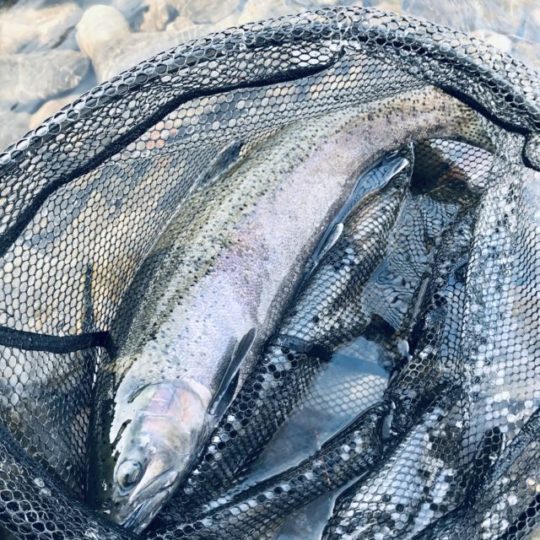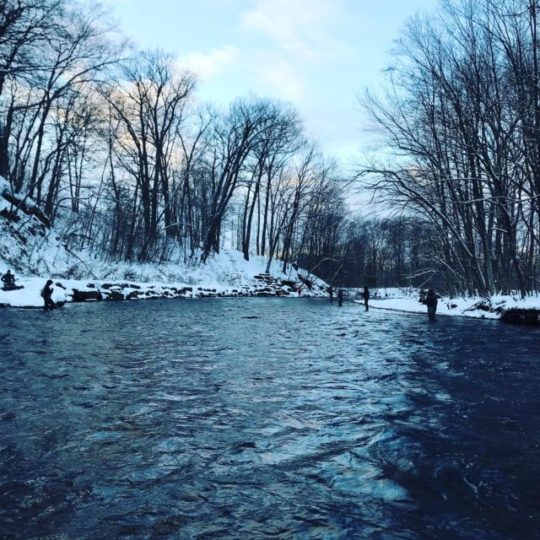After spending almost four full days last week at the Salmon River’s Lower Fly Zone (LFZ), I learned a lot (blog post here).
On my first trip to the Salmon River in March, I also hit the LFZ a few times, and it was there that I landed my first-ever steelhead. So, I’ve incurred enough miles on the wheels to express some opinions. Here are some personal lessons learned, including fly selection and technique.
KNOW THE REGULATIONS
The Salmon River has its own regulations, and the LFZ, in addition, has ones specifically for it. Fish wardens walk the banks periodically, and you don’t want to get fined. I write this because you want to fish that area with confidence that you’re within the rules.
You can read the regulations here, but the major ones that cover the LFZ are:
-
- Leaders must be 15 feet or less.
- There is no drop-shotting. The weight must be above the fly.
- The tippet length between the weight and fly must be less than four feet.
- No beads.
- Only a single fly with a single hook is allowed.
- Fly line is mandatory. So, no mono rigs.
- No running lines. So, no Euronymphing competition fly lines.
THE #1 ENEMY: THE COLD
I had neoprene waders on during my first trip. I fish throughout the winter (my suggested gear here). Yet, at the Salmon River, I still got cold quickly. It limited how much fishing I could do without taking a break.
This time, I changed up two things. And, it worked!
First, I bought some duck-hunting waders. A Salmon River regular advised me to get a particular set of boot-foot waders from Cabela’s (link here); and, get them two foot sizes bigger than what I usually wear. The logic? Wear two pairs of socks and have enough warm-ish air flow around your feet.
The waders’ magic is with the boots; they have 1600 grams of Thinsulate. I was comfortable all day during marathon sessions from before-dawn to dark.
I also wore two pair of socks. These polypropylene socks were comfortable and thin. I wore thick wool socks on top of them.
Second, I had nitrile gloves under my fishing gloves. It’s a tip I learned from well-known angler and guide Zach St. Amand. The gloves kept my hands dry. And, dry hands meant less-cold hands.
There’s a lot of precipitation in Altmar. You will be fishing in snow, rain, or sleet, at some point. And, you may be handling a steelhead. It’s inevitable: your hands will get wet and, thereby, cold.
I wore nitrile gloves under my regular fingerless fishing gloves. My hands never got cold when I added some hand warmers. And, the nitrile material was thin enough that tying on flies wasn’t a problem.
Those gloves are a no-brainer for winter fly fishing, IMO. You can order them here; as of this writing, a box of 100 gloves are $8.50, or $0.09 a glove.
FLY SELECTION: BE A CONTRARIAN
I tied up a bunch of flies, and most didn’t work. The ones that did, though, featured one of two traits: they either looked weird, or they were smaller. It was advice I got from UpCountry’s Torrey Collins, who used to guide at the Salmon River.
Regarding odd-ball flies, this is a lesson I learned at other pressured waters, such as the Swift and Farmington. The fish at such rivers are seeing every fly-store-bought egg pattern, streamer, and stonefly imaginable. So, if you design your own, you have a better shot.
Regarding fly size, most people throw #8 to #12 flies. I also added #14 to #18 to the mix and had good success.
But, I tightlined them and didn’t swing them. Doing so, would lead to a lot of foul hooking and lost rigs and flies. And, this leads me to the next point.
SHORTEN YOUR TIPPET AND REDUCE WEIGHT–AND, TIGHTLINE, TOO
I found on my first trip up that throwing and then swinging flies down and across on a four-foot tippet length with a lot of weight (the customary technique) resulted in a lot of foul hooking.
And, others have found the same.
At the Tailwater Lodge bar, I chatted with guide Finbarr McDowell. When I told him I was amazed that guys were connecting with fish at dawn while swinging flies at shallow and very cold water, his comment was this: “They’re foul hooking.”
The very next day, I ran into a friendly angler who was swinging flies all day at that same soft water. He had a lot of fish on the line. At the end of the day, we crossed paths. He admitted to me that most of his fish were foul hooked.
Why does this happen? Fish get “lined”: they sense the tippet or split shot graze their bodies and they surge forward, impaling themselves on a hook. Fish get “flossed”: the tippet will drift into a fish’s mouth, and you’ll hook the fish on the outside of the mouth on the jaw side facing away from you.
All this means that you lose a lot of flies. You also lose time, as you then have to re-rig. And, all that foul hooking isn’t great for the fish, IMO.
So, Torrey’s suggestion was this: tightline by casting above and across from you, use a tippet length of one- to two-feet, and deploy less weight (so that you tick bottom just once or twice a drift).
This worked! I had very few foul hook-ups vs. my first time out, and I saved a lot of flies and time. My Thomas and Thomas 1086 Contact six-weight (review here) did a great job, and I also tightlined with my “regular” 10-foot Orvis Helios 3D seven-weight when I felt I needed more backbone.
Tightlining also worked because it forced me to find some more quick water that featured slots, underwater boulders, and divots. In other words, I was at feeding lies. Swinging flies deep at resting lies might tempt a fish to opportunistically take. But, for me, I found I instead was snagging fish.
Now, I did at times swing flies, too. But, I used less weight and was on a short tippet. Also, I swung larger nymphs and streamers that the fish could see and avoid, if they wanted to. It just seemed like the right thing to do.
So, those are some personal lessons learned. How you fish is up to you.
As for me, I’ve found a technique, thanks to Torrey, that works and saves me time and money. It also makes me feel good about how I’m approaching the fish.
In my next post, I’ll describe the Euronymphing steelhead rig that I used. Stay tuned!
Discover more from BlogFlyFish.com
Subscribe to get the latest posts sent to your email.




Some good info you are passing on Jo, thanks for the shoutout
Absolutely! You’ve been incredibly generous, my friend! Another post in a few days on the steelhead tightlining rig you recommended. Stay tuned!
I do the same things on Erie Steelhead streams – same waders, socks, even the dish towel!
And you are absolutely right about tightlining unusual or small flies. One thing I do (learned from Dom at Troutbitten) is to wear sweatbands (tennis or basketball) on your wrists and put handwarmers under them. The sweatbands hold them in place and they do wonders keeping your hands warmer ( I wouldn’t say warm… haha)
Well, if I’m doing what you are, Bob, I’m on the right path!
Looks like regs have tightened up since my Salmon River days, but my 2wt flyline and sandbag setup would still be legal. Used to have good luck with an egg pattern: #12 wide gap fly hook, hot orange tail, orange foam floater (used in egg sacks) impailed and glued on shank, finished with two turns of hot orange hackle. It would suspend above the bottom. Of course it was toast after a fish took it, but easy to tie up a bunch.
thanks for the tips. haven’t made a winter trip up there and missed last springs trip but hope to be there this spring and i’m retiring this winter so maybe this is the year. how was the fishing pressure at lower fly zone? did you stay at tailwater? they ahven’t gone back to providing breakfasts have they? best beds (and food) in town thats for sure.
Thanks!
A lot of pressure.
I did stay at Tailwater.
They do offer breakfast, but I was already out on the river well before dawn and packed with me my food.
Good stuff – I do Erie tribs now every year – just back – great trip – seeing lots of anglers snagging intentionally and keeping – its a problem. I fly fish pretty much all winter up in MA and CT (ice fish when really cold). Two things to add: I use NRS neoprene gloves for fishing – they work great – the three fingers that fold back on each hand are both great and a pain at times – I put hand warmers in at the cuff of the glove – I have used plasti dip spray to make them more grippy on the outside. For my feet – I have over sized boots – 2 sizes up – I use a 2.5 mil neoprene sock (again NRS) as my base and then “Oros” heated socks over them – Lithium re chargeable batteries – have used them 2 seasons now – had one problem and they replaced the sock. The middle heat setting (3 settings) last for an 8 hour day! This system works and its 2 years now.
I hate that a mono rig is not allowed on that section – could help with less snagging! I guess I could use a 2 weight line with my contact 2, 6 weight if on the Salmon?